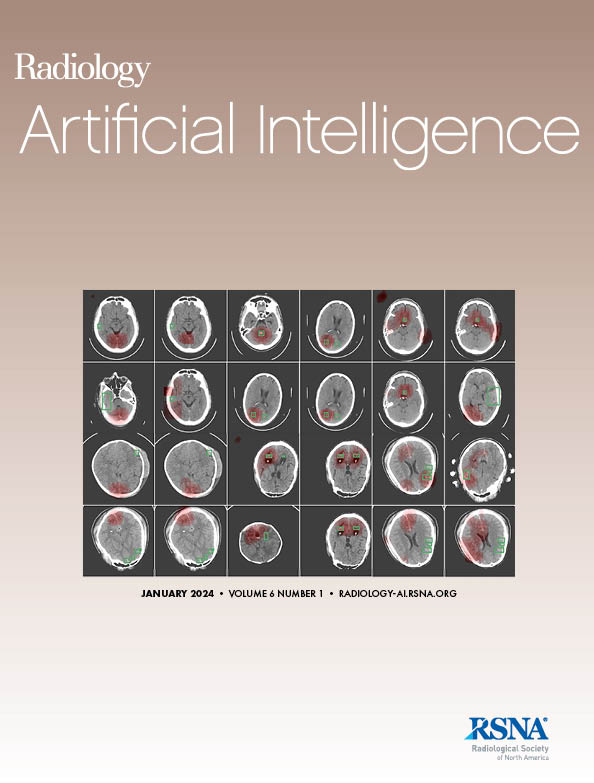Ashkan Moradi, Fadila Zerka, Joeran Sander Bosma, Mohammed R S Sunoqrot, Bendik S Abrahamsen, Derya Yakar, Jeroen Geerdink, Henkjan Huisman, Tone Frost Bathen, Mattijs Elschot
求助PDF
{"title":"优化联邦学习配置的MRI前列腺分割和癌症检测:模拟研究。","authors":"Ashkan Moradi, Fadila Zerka, Joeran Sander Bosma, Mohammed R S Sunoqrot, Bendik S Abrahamsen, Derya Yakar, Jeroen Geerdink, Henkjan Huisman, Tone Frost Bathen, Mattijs Elschot","doi":"10.1148/ryai.240485","DOIUrl":null,"url":null,"abstract":"<p><p>Purpose To develop and optimize a federated learning (FL) framework across multiple clients for biparametric MRI prostate segmentation and clinically significant prostate cancer (csPCa) detection. Materials and Methods A retrospective study was conducted using Flower FL (Flower.ai) to train a nnU-Net-based architecture for MRI prostate segmentation and csPCa detection using data collected from January 2010 to August 2021. Model development included training and optimizing local epochs, federated rounds, and aggregation strategies for FL-based prostate segmentation on T2-weighted MR images (four clients, 1294 patients) and csPCa detection using biparametric MR images (three clients, 1440 patients). Performance was evaluated on independent test sets using the Dice score for segmentation and the Prostate Imaging: Cancer Artificial Intelligence (PI-CAI) score, defined as the average of the area under the receiver operating characteristic curve and average precision, for csPCa detection. <i>P</i> values for performance differences were calculated using permutation testing. Results The FL configurations were independently optimized for both tasks, showing improved performance at 1 epoch (300 rounds) using FedMedian for prostate segmentation and 5 epochs (200 rounds) using FedAdagrad, for csPCa detection. Compared with the average performance of the clients, the optimized FL model significantly improved performance in prostate segmentation (Dice score, increase from 0.73 ± 0.06 [SD] to 0.88 ± 0.03; <i>P</i> ≤ .01) and csPCa detection (PI-CAI score, increase from 0.63 ± 0.07 to 0.74 ± 0.06; <i>P</i> ≤ .01) on the independent test set. The optimized FL model showed higher lesion detection performance compared with the FL-baseline model (PI-CAI score, increase from 0.72 ± 0.06 to 0.74 ± 0.06; <i>P</i> ≤ .01), but no evidence of a difference was observed for prostate segmentation (Dice scores, 0.87 ± 0.03 vs 0.88 ± 03; <i>P</i> > .05). Conclusion FL enhanced the performance and generalizability of MRI prostate segmentation and csPCa detection compared with local models, and optimizing its configuration further improved lesion detection performance. <b>Keywords:</b> Federated Learning, Prostate Cancer, MRI, Cancer Detection, Deep Learning <i>Supplemental material is available for this article.</i> © RSNA, 2025.</p>","PeriodicalId":29787,"journal":{"name":"Radiology-Artificial Intelligence","volume":" ","pages":"e240485"},"PeriodicalIF":13.2000,"publicationDate":"2025-09-01","publicationTypes":"Journal Article","fieldsOfStudy":null,"isOpenAccess":false,"openAccessPdf":"","citationCount":"0","resultStr":"{\"title\":\"Optimizing Federated Learning Configurations for MRI Prostate Segmentation and Cancer Detection: A Simulation Study.\",\"authors\":\"Ashkan Moradi, Fadila Zerka, Joeran Sander Bosma, Mohammed R S Sunoqrot, Bendik S Abrahamsen, Derya Yakar, Jeroen Geerdink, Henkjan Huisman, Tone Frost Bathen, Mattijs Elschot\",\"doi\":\"10.1148/ryai.240485\",\"DOIUrl\":null,\"url\":null,\"abstract\":\"<p><p>Purpose To develop and optimize a federated learning (FL) framework across multiple clients for biparametric MRI prostate segmentation and clinically significant prostate cancer (csPCa) detection. Materials and Methods A retrospective study was conducted using Flower FL (Flower.ai) to train a nnU-Net-based architecture for MRI prostate segmentation and csPCa detection using data collected from January 2010 to August 2021. Model development included training and optimizing local epochs, federated rounds, and aggregation strategies for FL-based prostate segmentation on T2-weighted MR images (four clients, 1294 patients) and csPCa detection using biparametric MR images (three clients, 1440 patients). Performance was evaluated on independent test sets using the Dice score for segmentation and the Prostate Imaging: Cancer Artificial Intelligence (PI-CAI) score, defined as the average of the area under the receiver operating characteristic curve and average precision, for csPCa detection. <i>P</i> values for performance differences were calculated using permutation testing. Results The FL configurations were independently optimized for both tasks, showing improved performance at 1 epoch (300 rounds) using FedMedian for prostate segmentation and 5 epochs (200 rounds) using FedAdagrad, for csPCa detection. Compared with the average performance of the clients, the optimized FL model significantly improved performance in prostate segmentation (Dice score, increase from 0.73 ± 0.06 [SD] to 0.88 ± 0.03; <i>P</i> ≤ .01) and csPCa detection (PI-CAI score, increase from 0.63 ± 0.07 to 0.74 ± 0.06; <i>P</i> ≤ .01) on the independent test set. The optimized FL model showed higher lesion detection performance compared with the FL-baseline model (PI-CAI score, increase from 0.72 ± 0.06 to 0.74 ± 0.06; <i>P</i> ≤ .01), but no evidence of a difference was observed for prostate segmentation (Dice scores, 0.87 ± 0.03 vs 0.88 ± 03; <i>P</i> > .05). Conclusion FL enhanced the performance and generalizability of MRI prostate segmentation and csPCa detection compared with local models, and optimizing its configuration further improved lesion detection performance. <b>Keywords:</b> Federated Learning, Prostate Cancer, MRI, Cancer Detection, Deep Learning <i>Supplemental material is available for this article.</i> © RSNA, 2025.</p>\",\"PeriodicalId\":29787,\"journal\":{\"name\":\"Radiology-Artificial Intelligence\",\"volume\":\" \",\"pages\":\"e240485\"},\"PeriodicalIF\":13.2000,\"publicationDate\":\"2025-09-01\",\"publicationTypes\":\"Journal Article\",\"fieldsOfStudy\":null,\"isOpenAccess\":false,\"openAccessPdf\":\"\",\"citationCount\":\"0\",\"resultStr\":null,\"platform\":\"Semanticscholar\",\"paperid\":null,\"PeriodicalName\":\"Radiology-Artificial Intelligence\",\"FirstCategoryId\":\"1085\",\"ListUrlMain\":\"https://doi.org/10.1148/ryai.240485\",\"RegionNum\":0,\"RegionCategory\":null,\"ArticlePicture\":[],\"TitleCN\":null,\"AbstractTextCN\":null,\"PMCID\":null,\"EPubDate\":\"\",\"PubModel\":\"\",\"JCR\":\"Q1\",\"JCRName\":\"COMPUTER SCIENCE, ARTIFICIAL INTELLIGENCE\",\"Score\":null,\"Total\":0}","platform":"Semanticscholar","paperid":null,"PeriodicalName":"Radiology-Artificial Intelligence","FirstCategoryId":"1085","ListUrlMain":"https://doi.org/10.1148/ryai.240485","RegionNum":0,"RegionCategory":null,"ArticlePicture":[],"TitleCN":null,"AbstractTextCN":null,"PMCID":null,"EPubDate":"","PubModel":"","JCR":"Q1","JCRName":"COMPUTER SCIENCE, ARTIFICIAL INTELLIGENCE","Score":null,"Total":0}
引用次数: 0
引用
批量引用

 求助内容:
求助内容: 应助结果提醒方式:
应助结果提醒方式:


